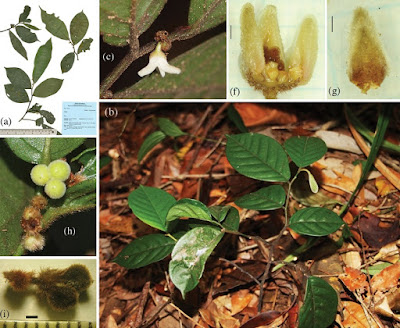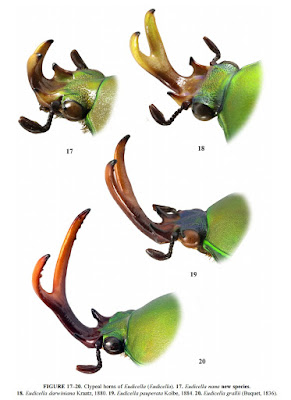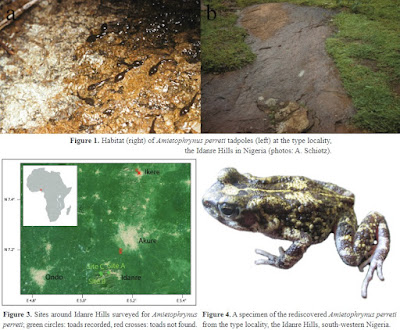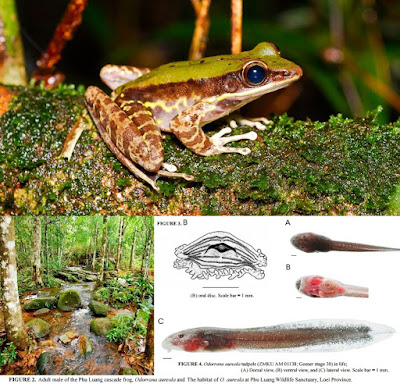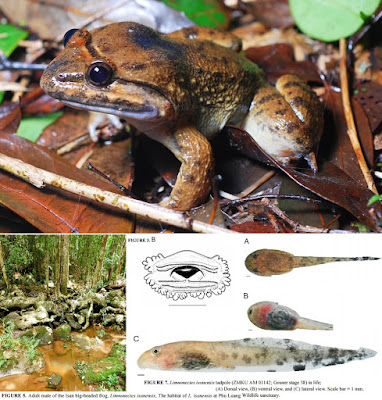[Most Recent Entries] [Calendar View]
Wednesday, July 13th, 2016
| Time | Event | ||||
| 6:50a | [Botany • 2016] Popowia bachmaensis • A New Species (Annonaceae) from Bach Ma National Park, Central Vietnam
Abstract A new species, Popowia bachmaensis Ngoc, Tagane & Yahara, sp. nov. is described from Bach Ma National Park in Thua Thien Hue Province, Central Vietnam. This species is morphologically similar to Popowia pisocarpa (Blume) Endl. ex Walp., but can be readily distinguished from it by its lower stems, smaller leaves, shorter flowering pedicels, shorter carpels, longer sepals and inner petals. A detailed description, comprising illustrations, and supplemented with DNA barcodes of the two regions of rbcL and matK, are provided. Keywords: Annonaceae, Bach Ma National Park, new species, Popowia, Vietnam
Taxonomy Popowia bachmaensis Ngoc, Tagane & Yahara, sp. nov. Diagnosis: Similar to Popowia pisocarpa (Blume) Endl. ex Walp., but distinguished from that species by having small habits (30–60 cm tall vs. 3–7 m tall in P. pisocarpa), smaller leaves (4.6–10.8 cm × 2.0–5.6 cm vs. 5.5–14 cm × 2.5–7 cm in P. pisocarpa), longer petioles (ca. 1.8–3 mm vs. 2–5 mm long) shorter flowering pedicels (2–3.5 vs. 4–7 mm long), longer sepals (ca. 3 mm vs. 2 mm long), longer inner petals (6 mm vs. 3 mm long), shorter carpels (2.1 mm vs. 10 mm long) (The measurements of P. pisocarpa derive from Sinclair 1955). Type: VIETNAM. Thua Thien Hue Province, Bach Ma National Park, in evergreen forest, 16°13'41.60"N, 107°51'09.35"E (DMS), alt. 485 m, 23 May 2015, with flowers and young fruits, Yahara T, Tagane S., Toyama H., Nguyen Ngoc, Nguyen Chinh, Okabe N. V2557 (holotype: KYO!; isotypes: BKF!, DLU!, FU!, the herbarium of Bach Ma National Park!). Distribution and habitat: Vietnam (so far known only from its type locality). Phenology: Mature flowers and young fruits were collected in May. Etymology: The specific epithet ‘bachmaensis’ is derived from the type locality, Mt. Bach Ma, Vietnam. Conservation status: Data Deficient (DD). During the botanical inventory carried out from 21 to 28 May 2015 from the foot to the top of Mt. Bach Ma, 15 individuals of Popowia bachmaensis were observed in all. They were found on the slopes of secondary hilly evergreen forest, at ca. 500 m elevation. Among them, only two individuals produced flowers, one produced fruits, and the others are just saplings. According to the population size observed, this species can be qualified as Critically Endangered (CR) (IUCN 2012). However, only a limited area of the forest in the vicinity of the type locality was surveyed, and further field surveys are needed to determine the actual population size within Bach Ma National Park. The forest of the type locality was slightly disturbed in the past, but it is now well-protected from human activities. Nguyen Van Ngoc, Shuichiro Tagane, Hoang Thi Binh, Hironori Toyama, Norikazu Okabe, Chinh Nguyen Duy and Tetsukazu Yahara. 2016. Popowia bachmaensis (Annonaceae), A New Species from Bach Ma National Park, Central Vietnam. PhytoKeys. 65: 125-131. DOI: 10.3897/phytokeys.65.8792 | ||||
| 7:33a | [Entomology • 2016] Eudicella nana • Morphology and DNA Barcoding reveal A New Species of Eudicella (Coleoptera: Scarabaeidae: Cetoniinae) from East Africa
Abstract A new species of Eudicella White, 1839 (Coleoptera: Scarabaeidae: Cetoniinae), is described from Uganda and Kenya: Eudicella nana new species. Morphological and genetic analyses of the new taxon and phenotypically allied species are given. Eudicella nana is compared with its hypothesized sister species, E. darwiniana Kraatz, 1880, and diagnostic characters that distinguish it from other species occurring in the same region are provided. Keywords: Coleoptera, beetle, COI, Uganda, Kenya, integrative taxonomy Eudicella (Eudicella) nana Seidel, 2016 Diagnosis. This species can be distinguished from other Eudicella (Eudicella) species based on the following combination of characters: clypeus tawny and green iridescent at its base; clypeal fork short and narrow (Fig. 17); pygidium rugosely sculptured (Figs. 7–8); labium deeply punctate in males (Fig. 4) and rugose in females (Fig. 5); wings transparent, tawny with a dark brown bar close to the tip (Fig. 3). Furthermore, the form of the parameres is unique for E. nana and E. darwiniana and can be distinguished from the other species in the genus (Fig. 6). Etymology. The species name is derived from the Latin word for dwarf (nanus) as it is the smallest species in the subgenus Eudicella. Matthias Seidel. 2016. Morphology and DNA Barcoding reveal A New Species of Eudicella from East Africa (Coleoptera: Scarabaeidae: Cetoniinae). Zootaxa. 4137(4); DOI: 10.11646/zootaxa.4137.4.5 | ||||
| 8:45a | [Herpetology • 2014] The Rediscovery of Perret’s Toad, Amietophrynus perreti (Schiøtz, 1963) after more than 40 years, with Comments on the Species’ Phylogenetic Placement and Conservation Status
Abstract Perret's toad, Amietophrynus perreti, has not been seen since 1970 and thus believed to be lost. We searched for the species 50 years after its original description and successfully recorded its continued presence at the type locality, where it seems to maintain a viable population. We failed however, to record the species at suitable sites elsewhere and A. perreti could thus indeed be a micro-endemic species, specialized and restricted to the granite inselbergs of the Idanre Hills, Nigeria. We recorded and discuss potential threats and suggest keeping the toad's current conservation status as 'Vulnerable'. We investigated the systematic status of Perret's toad using a mitochondrial fragment of the 16S rRNA gene and could confirm that it is a member of the genus Amietophrynus despite its aberrant larval biology, different to the rest of the genus. In spite of this biological difference, A. perreti is not a phylogenetically isolated lineage, but is nested within a clade of western African Amietophrynus species, such as A. maculatus, A. regularis, A. latifrons and A. togoensis and is sister to the widespread and savannah dwelling A. maculatus. Abiodun B. Onadeko, Mark-Oliver Roedel, H. Christoph Liedtke and Michael Barej. 2014. The Rediscovery of Perret’s Toad, Amietophrynus perreti (Schiøtz, 1963) after more than 40 years, with Comments on the Species’ Phylogenetic Placement and Conservation Status. Zoosystematics and Evolution 90(2): 113-119. DOI: 10.3897/zse.90.8234 | ||||
| 8:59a | [Herpetology • 2015] Description of the Tadpoles of Two Endemic Frogs: the Phu Luang Cascade Frog Odorrana aureola (Anura: Ranidae) and the Isan Big-headed Frog Limnonectes isanensis (Anura: Dicroglossidae) from northeastern Thailand
Abstract We describe the external morphology of the tadpoles of two frogs endemic to Thailand: the Phu Luang cascade frog (Odorrana aureola) and the Isan big-headed frog (Limnonectes isanensis) from the type localities in the Phu Luang Wildlife Sanctuary, Loei Province, northeastern Thailand. Morphological and genetic characters (16S rRNA) were used to identify specimen and match tadpoles to the adults. Detailed descriptions of external morphology and coloration in life are provided for both species. We provide a brief discussion of the ecology of these tadpoles and a comparison to previously published data from tadpoles of closely related taxa. Additionally, we provide evidence for the utility of larval morphology in resolving the taxonomic puzzles presented by cryptic species complexes. Keywords: Amphibia, amphibian, biodiversity, conservation, morphology, mitochondrial DNA, species complex Ampai, Natee, Attapol Rujirawan, Jirachai Arkajag, David S. Mcleod & Anchalee Aowphol. 2015. Description of the Tadpoles of Two Endemic Frogs: the Phu Luang Cascade Frog Odorrana aureola (Anura: Ranidae) and the Isan Big-headed Frog Limnonectes isanensis (Anura: Dicroglossidae) from northeastern Thailand. Zootaxa. 3981(4): 508–520. DOI: 10.11646/zootaxa.3981.4.3 |
| << Previous Day |
2016/07/13 [Calendar] |
Next Day >> |
